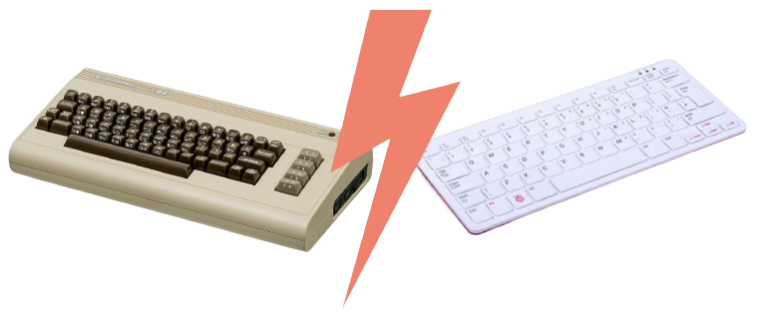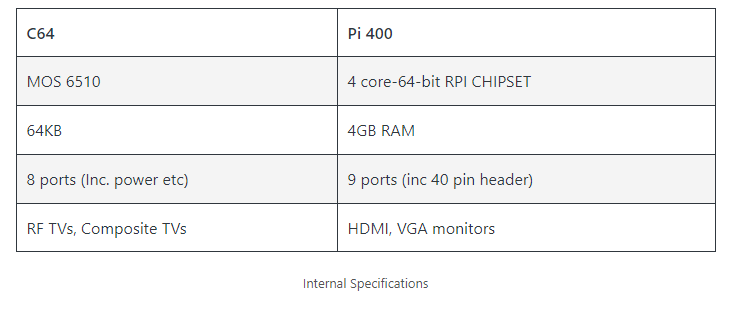
The C64 is one of the best home-computers made in a long time. With its compact structure and superior performance, it allowed people at home to start using the computer at their own homes. With its breadbin style (and futuristic style [64C]) case, it was compact with all features.

The C64 was useable with a TV or a dedicated monitor. And it also came with a RF modulator for use with old style TVs (which were common at the time). The C64 became highly famous thanks to its extended game collection which gave fierce competition to Atari, and many more game console makers. What gave this computer its edge would be its gaming capabilities with programming and home computer capabilities. This meant that kids could play games and the parents can do accounts in dedicated software.
The C64 came built in with BASIC and it also came with a good manual with dedicated “Learn Coding” sections for people to enter the coding race. An external OS of sorts called GEOS was also available adding extended features like spreadsheets, word (text) and so on which when used by users really helped them (Not sure how many used it though). Games came on cartridges and on disks. The machine also had a disk drive which was used to read the disks.


The cartridge port indirectly gave access of the in-built GPIOs to the people hereby helping people mod them. And this also helped in running interesting peripherals for it.
The device came with joystick ports so that people could play games with a joystick and this also made the market for this computer bigger.
The 6510 chip was advanced for its time and the inbuilt VIC graphics chip also helped the device in a huge way.
Returning to the present:
The RPI400 is a minicomputer which has an inbuilt keyboard along with USB ports and hardware GPIO outputs.

The device can run Raspberry Pi’s own OS (Formerly: Raspbian) or even worse/better Operating systems like Ubuntu, heck, Windows even. Can you find a hint? Well, like mentioned before, even the C64 had an OS (UI source) called GEOS. (Graphic Environment Operating System).
The c64 also had external peripherals like mice available which helped users navigate with an, of course, mouse. Similarly, even the RPI400 has an option of working with a mouse.

Coming to games, with the inbuilt RPI OS, Minecraft is available. And many of the gamers know and like the game. The device is also capable enough to run other games. But since the device can also run windows (to an extent) other games can be played as well. But they are yet to be fully tested.
When it comes to hacking, the RPI comes with the GPIO exposed wherein people need not hack the USB ports to gain access :). And this makes it a very good educational computer similar to the c64. (Other factors also apply which will be touched on shortly).
The RPI comes with Linux built in. Other OS’s can be accessed with the help of the SD card port and a SD card.
The above point also shows that the RPI’s memory is indirectly expandable. Similarly, even the C64s memory is expandable.
The 400 has an ethernet port. Of course, the concept of internet was pretty scarce (thanks to cost) back then. But the c64 could dial to the internet (dial-up) with dedicated software and hardware and people who really wanted it, did it.
One massive similarity would be the keyboards. The 400 and c64 have a keyboard built in hereby making it compact and small. The 400 has the keyboard in multiple languages and the c64 had it in various combinations too.


Complete peripherals
The c64’s joystick made it a great gaming PC as mentioned before. And yes, a USB joystick can be used with the 400 too. (Awesome right?)
The very few limitations that the 400 has would be being able to run mega games. It is not an unfixable problem. And if a ram expander similar to the ones made for the c64 are made, then yes, it has all capabilities to become a superior gaming device.
Educational Market was one of the key buyers of the c64 with the home market. And this is one of the key buyers of the RPI400 too. And since the 400 also has exposed GPIO and does not need mods like the c64, it becomes a great learning PC that a student of ANY AGE can use.
The c64 also came with BASIC which allowed students to learn easily. Similarly, the 400 comes with features to use Python which can help people learn the language if they don’t know it yet.
The manual was one of the best manuals of the time with tutorials, and hardware schematics. Similarly, even the 400 comes with a great manual which can be used to learn (for beginners and all users in general)


The physical structure of both computers is very similar.
Unfortunately, we cannot compare the specs of both computers since they are from completely different generations. But the number of similarities, begs the question:
Did Raspberry Pi get inspired by the C64 to make the 400?
Anyhow, since we have done an extensive comparison, Let’s have a look at all of it in a tabular form for easier understanding:

PC Specs (Even though I said that, I won’t be going in too much detail):

All of this goes to show. Yes. We can call the RPI400 the C64 of this era. But the C64 will always remain a C64 and a PI400 will remain a RPI400!
Thanks a lot for reading!
References:
- Data: The 8 Bit Guy, Raspberry Pi.org
- C-64 Image: Wiki media.
- RPI 400 Image: raspberrypi.org
- C64 Peripherals: National Museum Of Computer History
- Pi 400 Peripherals: raspberrypi.org
- GEOS Details: wikipedia.org
- GEOS Example: lyon labs
- C64 Game Screenshot: Moby Games
- C64 Manual: ManualsLib
- Heavy Gaming on the PI 400: LowSpecGamer
- Links: the8bitguy.com , raspberrypi.org , https://manualslib.com/ , https://www.lyonlabs.org/ , mobygames.com , youtube.com/c/LowSpecGamer
Respective Trademarks and Copyrights belong to respective owners.
Leave a Reply